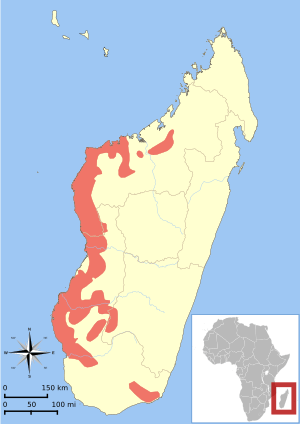Gray mouse lemur facts for kids
The gray mouse lemur (Microcebus murinus) is a tiny type of lemur that lives only on the large island of Madagascar. It's also known as the grey mouse lemur or the lesser mouse lemur. These small creatures weigh about 58 to 67 grams (2.0 to 2.4 oz), which is about the same as a small apple! Even though they are very small, they are actually the largest among all mouse lemur species.
Quick facts for kids Gray mouse lemur |
|
|---|---|
 |
|
| Conservation status | |
|
Not evaluated (IUCN 3.1)
|
|
| Scientific classification | |
 |
|
| Distribution of Microcebus murinus | |
| Synonyms | |
|
Contents
Where do gray mouse lemurs live?
Gray mouse lemurs live in different types of forests across Madagascar. They can be found in dry deciduous forests, which lose their leaves in the dry season. They also live in spiny forests and even some areas of rainforests. These lemurs are very good at adapting to different environments.
Their forest home
These tiny lemurs spend most of their lives high up in the trees. They use their strong grip and quick movements to move through branches. The dense forest canopy provides them with safety from predators and plenty of food.
What do gray mouse lemurs eat?
Gray mouse lemurs are omnivores, meaning they eat both plants and animals. Their diet changes depending on the season and what food is available.
Seasonal diet changes
- Wet season: During the rainy season, they mostly eat fruits and insects. The rain helps many plants grow, so there's lots of fruit. Insects are also more active and easier to find.
- Dry season: In the dry season, food can be harder to find. They might eat more nectar, flowers, and even tree sap. They also hunt small vertebrates like tiny lizards or frogs.
How do gray mouse lemurs behave?
These lemurs are nocturnal, which means they are active at night. They have very large eyes that help them see in the dark. During the day, they sleep in tree holes or nests made of leaves.
Sleeping habits
Gray mouse lemurs often sleep alone or in small groups. They curl up tightly to save energy and stay safe. Sometimes, they enter a special deep sleep called torpor during very dry or cold periods. This helps them survive when food is scarce.
Communication and senses
They use a variety of sounds to talk to each other, including chirps and whistles. They also use their excellent sense of smell to find food and recognize other lemurs. Their long whiskers help them feel their way around in the dark.
Reproduction and life cycle
Gray mouse lemurs usually have their babies during the wet season, when there is plenty of food. This gives the young lemurs the best chance to grow strong.
Baby lemurs
A mother gray mouse lemur typically gives birth to two or three tiny babies at a time. The babies are born very small and helpless. They cling to their mother's fur for the first few weeks. The mother takes care of them until they are old enough to find food on their own.
Lifespan
In the wild, gray mouse lemurs usually live for about 6 to 8 years. However, in zoos or special care, they can live much longer, sometimes up to 15 years!
Conservation status
The gray mouse lemur is currently listed as "Least Concern" by the IUCN Red List. This means they are not immediately threatened with extinction. However, their habitat in Madagascar is shrinking due to deforestation.
Threats to their home
- Deforestation: Forests are being cut down for farming, logging, and charcoal production. This destroys the homes of many animals, including the gray mouse lemur.
- Climate change: Changes in weather patterns can affect the availability of food and water.
It's important to protect the forests of Madagascar to ensure these unique lemurs continue to thrive.
Images for kids
See also
 In Spanish: Lémur ratón gris para niños
In Spanish: Lémur ratón gris para niños



